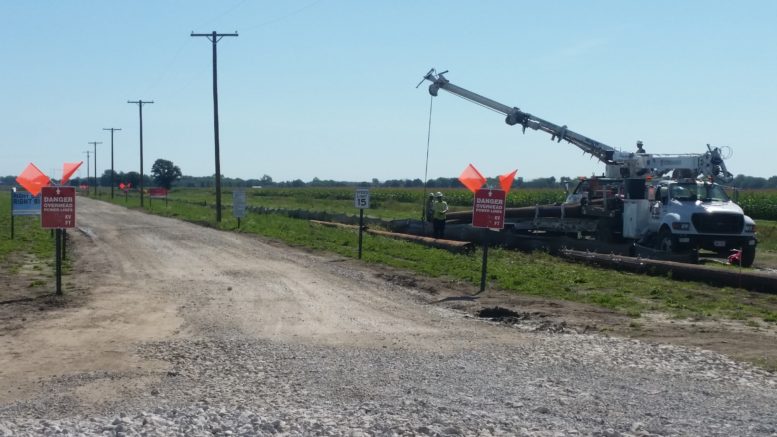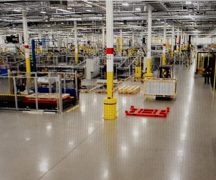By JAN LARSON McLAUGHLIN
BG Independent News
A shadow of doubt has been cast over the hiring practices at the massive solar field being built northeast of Bowling Green.
Claims have been made that the project is not adhering to the requirement that 80 percent of those employed at the site be Ohio residents. That percentage was a primary factor in the Wood County Commissioners approving a tax abatement for the project.
And concerns have been expressed by city officials that there was an expectation that the project would pay prevailing wages.
Officials from the electric subcontractor at the site, Blattner Energy, and the contractor for the project, NextEra Energy, both strongly defended their compliance with the 80 percent rule. However, they also clarified that the project has no requirement to pay prevailing wages.
The giant solar project has been welcomed as good for the environment and good for the area’s reputation since it will be the largest solar field in Ohio. The project is located on 165 acres owned by the City of Bowling Green at the southeast corner of Carter and Newton roads. The solar array will consist of 85,680 panels that will track the sun from east to west everyday for maximum power generation.
But from the beginning, the solar project stirred up a bit of controversy. The Wood County Commissioners initially refused to grant the requested 30-year tax abatement for the $43 million project until their questions were answered.
The tax abatement request for the solar field was unlike those that normally come before the commissioners. First, the amount is massive, giving a tax break of $7.3 million over just the first 15 years. Second, the abatement duration is 30 years, compared to the customary 10 to 15 years.
Third, there is no ongoing employment, which is the basis for most tax breaks. Construction of the solar field will employ about 85 people from July 18 to Dec. 31. And while 80 percent of those people are required to be Ohio residents – there is no requirement that they come from Wood County.
Fourth, regular tax abatements require that school districts be “made whole” by the business getting the tax break, but this agreement does not. The company will pay some money to local taxing authorities “in lieu of” the tax breaks, but not the entire amount.
The commissioners also voiced concerns that the solar array will be built using panels from Hanwha, a South Korean company – not Wood County’s First Solar company.
However, it was made clear that without the tax break, the solar field would not be built here by NextEra and AMP.
The commissioners approved the tax abatement. Despite concerns about the project not using local solar panels, they were pleased that the jobs would at least have a potential local benefit, Commissioner Joel Kuhlman said.
But when Kuhlman started asking questions a few weeks ago about the 80 percent Ohio workforce, the answers he got were less than satisfying.
“It is part of the abatement agreement,” Kuhlman said, explaining that he contacted NextEra officials for specifics. “They did not give me any statistics about how many of the people were from Ohio. I have not been given any proof they have met that requirement at this time.”
Bowling Green City Council members Mike Aspacher and Bruce Jeffers were also told that a “relatively high number” of local people were being hired, many from local unions.
“We have been and continue to be interested in local labor being used on that project,” Aspacher said. Aspacher said he had been specifically told that electricians from Local 8 in Rossford were being used on the solar field.
However, Local 8 officials said earlier this week that all their electricians had been shut out of the job when the contractor found out they were union. They also said Blattner Energy may be meeting the 80 percent Ohio worker requirement, but only by skirting the rules.
According to Perry Hester, in Local 8 membership development, Blattner Energy has gotten local apartment housing for several out-of-state employees. “It’s an illusion that they are from Ohio,” he said.
Because the union was shut out of jobs, Local 8 placed a “covert salt” at the job site. That term refers to an employee who does not disclose his union membership, and works at a site to check out the job conditions.
That “covert salt,” John Corfman, said he noticed many workers showing up in vehicles with license plates from Georgia, Tennessee and Minnesota. According to Corfman, in order to meet the 80 percent requirement, many of those workers were asked to get Ohio driver’s licenses and plates.
But NextEra and Blattner officials denied any improper actions.
NextEra Energy Resources’ Matthew Roskot said his company is taking the employment requirement very seriously. “We are aware of the 80 percent requirement and we are working to make sure we are meeting the requirement.”
NextEra communications and media relations person Steve Stengel said Blattner Energy was responsible for hiring for the project. But he assured that both NextEra and Blattner are committed to meeting the requirement.
“I understand the concern, but we have an obligation to meet the 80 percent,” Stengel said. “The contractor is legally obligated to deliver that. We review this issue on a monthly basis.”
Stengel said verification of Ohio residency is proven with the worker’s driver’s license and by the worker signing a document stating residency.
“We are very comfortable with this,” Stengel said.
Blattner Energy’s solar director, Stephen Jones, said his company accepts Ohio driver’s licenses as proof of residency in the state. He said the company has not asked any workers to become residents of Ohio for the project. “We have not asked anybody to do anything of that nature.”
Jones also said Blattner Energy does not provide housing for workers. “Blattner does not rent any houses or apartments.” The company does, however, pay workers a per diem amount that they can use for rent.
The 80 percent requirement is being adhered to very carefully, Jones said. “We do track it on a daily basis.” As of this week, the job had 84.9 percent Ohio residents – more than mandated. “We have the right to hire non-residents,” he added.
But Kuhlman is not satisfied, and wants more answers.
“It would be really disappointing to me if they were going out of their way to do that,” to bend the rules, he said. “I expect the county will be on them with a very watchful eye.”
Bowling Green Mayor Dick Edwards was also interested in getting answers.
“I am very concerned about it. I think we need to get at the facts,” he said. “We’ve got to do this right.”
Aspacher shared those concerns.
“This is very troubling to me. The residents of Bowling Green and Wood County have a stake in this project.” And local workers need a fair opportunity for jobs, Aspacher said.
Edwards and Aspacher said the city is trying to clarify who is responsible for making sure the 80 percent requirement is met.
Local 8 officials hold all the companies involved responsible. “NextEra is letting Blattner do this, and AMP hired NextEra,” said Tom Enright, of Local 8 membership development. “They are all at fault.”
Both Aspacher and Jeffers said they had been told that prevailing wages were being paid at the project, even though it is not a union operation. But most of the workers are earning between $12 and $17 an hour, Corfman said.
“I think Bowling Green and Wood County had every intention that this be a prevailing wage job,” Enright said.
But Jones made it clear that Blattner had no such obligation. “This is not a prevailing wage job,” he said.
He denied, however, that his company refuses to hire union workers.
“That is not a practice of Blattner,” Jones said. Employees are selected based on their attitudes, work experience, skill set, interview demeanor, and compensation demands.
Stengel agreed that the hiring was left to the discretion of Blattner, but added, “There was no excluding” of union applicants.
Corfman said union workers may have been turned down, not only because of their pay rate, but because of their standards. He said that workers are given no lunch or other break times, have no nearby restrooms, no handwashing stations, and no shade.
“Union people probably wouldn’t put up with that,” Corfman said.
Corfman said the solar job did not need to go outside the region for qualified workers. “We could give them as many as they want.”
About 20 union electricians applied for the job with Blattner, according to Enright. “They said over and over, they couldn’t believe how qualified our guys were,” Enright said. But when Blattner found out they were union, the answer was “was can’t hire you,” he said.
Corfman said his main goals as a “covert salt” are to show the employer the superior skills of union electricians and convince non-local workers of the value of becoming union.
“I want to win them over,” he said.
The goal is never to sabotage a worksite. “It’s not like the old days,” Corfman said. “What we do now is sue.”





